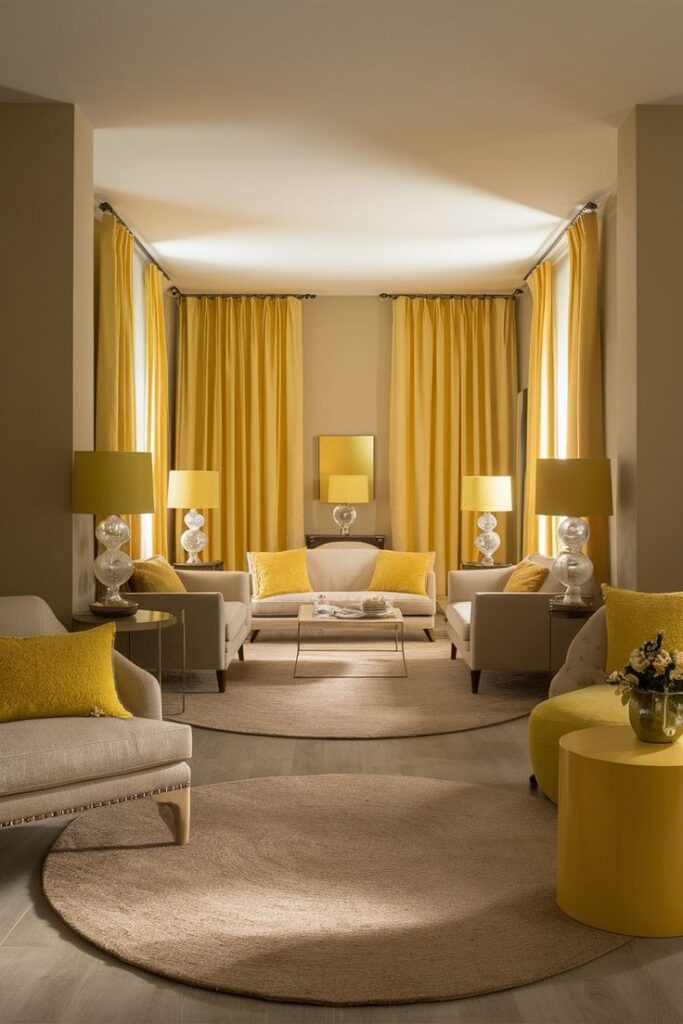

Yellow Pantone style in home design brightens spaces with energy and warmth. Using the right shade of yellow can create a cheerful, inviting atmosphere without overwhelming the room. It works well in various areas, from living rooms to kitchens.
Choosing the proper tone of yellow is key to balancing brightness and comfort. Yellow Pantone shades can be bold or soft, and they blend easily with neutral colors. This makes it simple to add personality through walls, furniture, or decorations.
Yellow also helps small spaces feel larger and more open. By carefully integrating it through accents or paint, homes can achieve a fresh and modern look that stays timeless.
Key Takeaways
- Yellow Pantone adds energy and warmth to any room.
- Picking the right yellow shade helps keep a balanced and welcoming space.
- Yellow accents can make small areas feel open and inviting.
Understanding Yellow Pantone Style


Yellow Pantone colors vary in tone and brightness, each creating a different mood in a room. These shades can be warm or cool, bright or muted, and they influence how a space feels and looks.
The meaning behind yellow in design also plays a big part. It affects energy, mood, and perception in home interiors.
What Is Pantone Yellow?


Pantone Yellow is a specific color standard created by the Pantone Color Institute. It ensures consistent color reproduction across different materials and products.
This yellow is bright and pure, often used as a base for other colors. It has a high level of visibility, making it great for accent pieces or focal points in a room.
Pantone Yellow is distinct from regular yellow paint. It is used by designers and manufacturers to avoid color mismatch. This helps keep a home’s style consistent and professional.
Popular Yellow Pantone Shades


There are many popular yellow Pantone shades used in homes today. Some examples include:
- Pantone 13-0647 Illuminating: A bright, cheerful yellow that brightens rooms.
- Pantone 14-0957 Saffron: A deeper, warmer yellow with hints of orange.
- Pantone 12-0825 Mini Me: A soft, muted yellow, good for calm spaces.
Each shade has different intensity and warmth. Designers pick shades depending on the room’s purpose and lighting conditions.
Psychology of Yellow in Interior Design


Yellow affects emotions and behavior in interior spaces. It is often linked to happiness, optimism, and energy.
In homes, yellow can stimulate creativity and conversation. Rooms painted or decorated with yellow often feel lively and welcoming.
However, too much bright yellow may cause restlessness or eye strain. Warmer or muted yellows are better for relaxation areas.
Yellow also impacts how people perceive space, making rooms feel larger and more open when used correctly.
Choosing the Right Yellow Pantone for Your Home
Choosing the perfect yellow Pantone depends on room lighting, space size, and color combinations. It also requires attention to finishes and materials to create balance and style.
Assessing Lighting and Space

Natural and artificial light greatly affect how yellow tones look. Bright yellows can feel overwhelming in small, dark rooms but bring energy to well-lit spaces.
Warm, soft yellows work well in rooms with less natural light. Cool yellow shades suit sunny rooms but might feel cold under artificial lights.
The room’s size matters. Lighter yellows can make small rooms feel larger. Darker yellows add coziness to spacious areas without shrinking them visually.
Pairing with Other Color Palettes

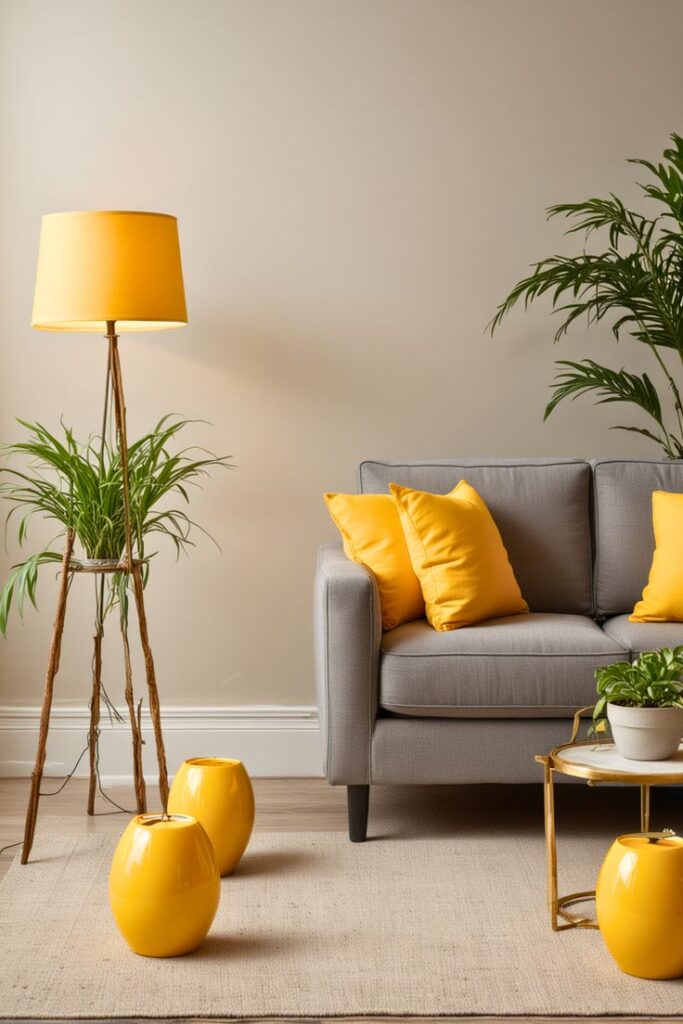
Yellow pairs well with many colors but needs careful matching. Neutral tones like gray, white, and beige balance yellow’s brightness.
For a bold look, combine yellow with navy blue or charcoal gray. These colors provide contrast without clashing.
Pastel yellows work nicely with soft greens and pinks. Avoid pairing intense yellow with strong reds or oranges, which can overwhelm a space.
Selecting Finishes and Materials


Matte yellow finishes soften brightness, good for walls and large surfaces. Glossy yellows add shine but suit smaller elements like furniture or accessories.
Textures impact yellow’s feel. Rough textures like linen or wood warm the yellow, while smooth or metallic surfaces enhance its brightness.
Consider the room’s function. Durable, easy-to-clean finishes suit kitchens and bathrooms. Softer finishes work for bedrooms or living areas.
Integrating Yellow Pantone Style in Living Areas
Yellow Pantone can brighten living spaces and add warmth. It works best when balanced with neutral tones or used as a bold statement. Strategic placement helps prevent the color from overwhelming the room.
Accent Walls and Feature Spaces


Using yellow Pantone on an accent wall draws attention without covering the entire room. It pairs well with light gray, white, or soft beige walls to create contrast.
Feature spaces like niches or areas around a fireplace can benefit from yellow. This highlights these spots and adds brightness without cluttering the room.
Yellow works well in rooms with plenty of natural light. It can make the space feel cheerful and inviting. Avoid using yellow on every wall to keep the room from feeling too intense or small.
Textiles and Upholstery Choices


Yellow textiles add warmth and comfort to living areas. Throw pillows, curtains, and rugs in yellow Pantone can lift neutral furniture without being overpowering.
Upholstery in yellow is best suited for statement pieces like an armchair or ottoman. Mixing yellow cushions with neutral sofas creates a balanced look.
Materials such as linen, cotton, or velvet in yellow add texture and depth. Using different shades of yellow in textiles can add interest while keeping a cohesive style.
Yellow Pantone in Kitchens and Dining Spaces


Yellow Pantone brings energy and brightness to kitchens and dining areas. It can be used in large features like cabinetry or smaller accents like dishes and decor items. This color pairs well with neutral tones and natural materials to create a lively but balanced space.
Cabinetry and Backsplashes

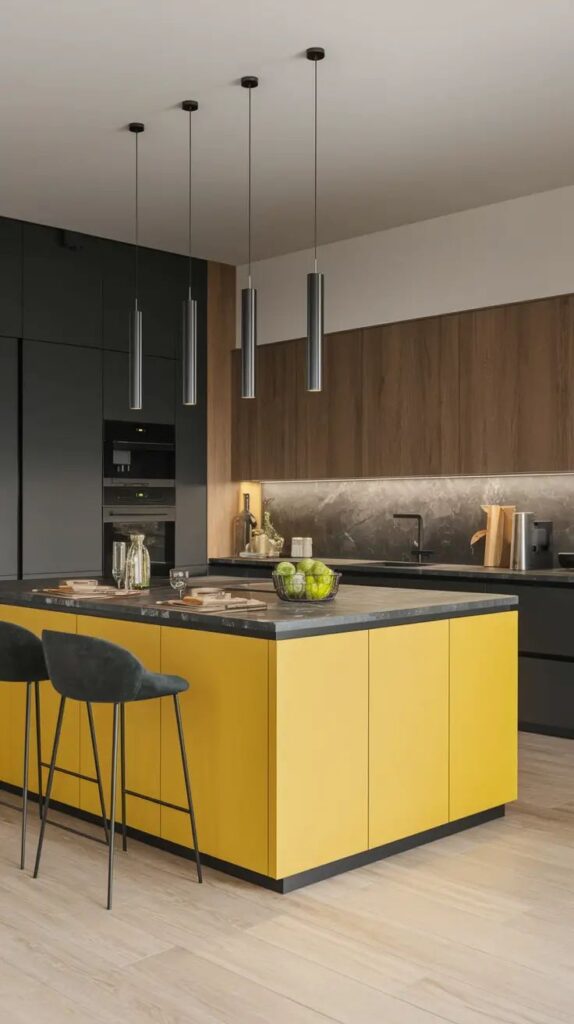
Yellow cabinetry offers a bold statement in kitchen design. It works well in both modern and traditional styles, especially when paired with white countertops or stainless steel appliances. Cabinets painted in soft yellow Pantone shades can make the space feel warm and inviting without overwhelming the room.
Backsplashes in yellow add a pop of color behind sinks and stoves. Tiles or glass panels in yellow Pantone shades brighten the area and make cleaning easier. This choice can complement neutral walls and floors while adding an unexpected but pleasant contrast.
Tableware and Decorative Elements


Yellow tableware like plates, bowls, and mugs can bring cheer to everyday meals. Choosing matte or muted yellow Pantone shades keeps the look stylish and prevents it from feeling too loud. Mixing yellow dishes with white or grey pieces adds depth and variety.
Decorative elements such as vases, napkins, and cushions in yellow highlight the dining space subtly. Small items in bright yellow bring warmth without clutter. Yellow-painted chairs or linens can create coordination, tying the whole area together.
Incorporating Yellow Pantone in Bedrooms


Yellow Pantone brings warmth and brightness to bedrooms without overwhelming the space. It works well when used thoughtfully in textiles and lighting, creating a calming yet cheerful environment.
Bedding and Soft Furnishings


Using Yellow Pantone in bedding is an effective way to introduce color without overpowering the room. Yellow sheets, pillowcases, or duvet covers can add a lively touch while keeping the space cozy.
Soft furnishings like cushions or throws in varying shades of yellow can create layers of warmth. Combine these with neutral tones like gray, white, or beige to balance the brightness. Patterns that include yellow highlights help tie the look together.
Choosing natural fabrics like cotton or linen keeps the space comfortable. Yellow accents in rugs or curtains also complement bedding without being too bold.
Lighting Solutions


Yellow Pantone in bedroom lighting can set a soft, inviting mood. Lampshades or light fixtures with yellow tones diffuse light gently, reducing harshness.
Warm LED bulbs with a yellow hue mimic natural sunlight, promoting relaxation. Positioning lights near seating or reading areas enhances functionality and style.
Using dimmable lights lets occupants adjust brightness depending on the time of day. This flexibility ensures the yellow lighting supports both calm evenings and morning energy.
Decorative Accents and Accessories


Using yellow Pantone shades in a home’s decorative items creates bright spots that lift the room’s mood. Art, furniture, and textiles in this color can highlight certain areas without overwhelming the space.
Art and Wall Décor


Yellow art pieces draw attention and add energy to a wall. Prints or paintings with yellow highlights work well in living rooms and kitchens.
Bold yellow frames can enhance black-and-white photos or simple sketches. Abstract art with various shades of yellow brings warmth and visual interest.
Wall decals or tapestries including yellow Pantone shades brighten dull corners. They also complement neutral walls, creating a cheerful focal point without clashing.
Statement Furniture Pieces


Single furniture items in yellow Pantone stand out and can anchor a room. A yellow armchair or sofa gives a fresh, modern look.
Tables or stools with yellow paint or upholstery add a playful touch to minimal decor. Yellow cabinets or shelves work well in kitchens and offices, blending style with function.
Choosing matte or soft yellow finishes helps avoid harshness. The color invites conversation but still fits comfortably with other hues.
Rugs, Cushions, and Throws


Yellow textiles bring color in easy-to-change ways. Cushions or throws with yellow tones make sofas and beds more inviting.
Layering different yellow shades or patterns adds texture and depth. Rugs with yellow accents tie spaces together, balancing floors with walls and furniture.
These accessories offer flexibility. They brighten rooms seasonally or boost color in otherwise plain designs.
Styling with Yellow Pantone in Small Spaces


Yellow Pantone can brighten and open up small rooms by adding energy and depth. Using this color in the right way helps avoid overwhelming the space while making it feel lively and inviting.
Creating Visual Interest


Yellow Pantone adds a bold yet warm look to small areas. It works well on accent walls or furniture to create a focal point without crowding the room.
Using varied textures like a yellow velvet chair or a matte paint finish keeps the eye engaged. Pairing yellow with neutral tones balances the brightness and prevents the space from feeling too busy.
Small decor items such as throw pillows, artwork, or lamps in yellow Pantone bring pops of color. These pieces punctuate the space and stop it from looking flat or dull.
Optical Effects and Room Dynamics

Yellow Pantone reflects light, making rooms feel airier and more open. It can make ceilings seem higher and walls wider when used on certain surfaces.
For the best effect, apply yellow on walls that face natural light sources. This enhances brightness without requiring extra lamps.
Using yellow in combination with mirrors or glass furniture multiplies the light and causes the room to seem larger. Avoid overusing yellow on large surfaces to prevent a cramped feel.
Strategic placement of yellow maintains balance and supports better flow within compact spaces.
Maintaining a Balanced Yellow Pantone Aesthetic


Using yellow in home design requires careful choices to keep rooms bright without feeling overpowering. Adjustments over time help the space stay fresh and suit changing seasons or moods.
Avoiding Overwhelming Color Use
Too much yellow can make a room feel intense or tiring. It is best to limit yellow to one or two walls or use it in smaller accents, like pillows or lamps.
Pairing yellow with neutral tones such as gray, white, or beige helps balance its brightness. Using matte or softer shades of yellow also reduces the risk of overwhelming the space.
Texture and pattern variety add interest without increasing color intensity. For example, a yellow patterned rug with neutral furniture keeps the room lively but grounded.
Seasonal Adjustments and Updates
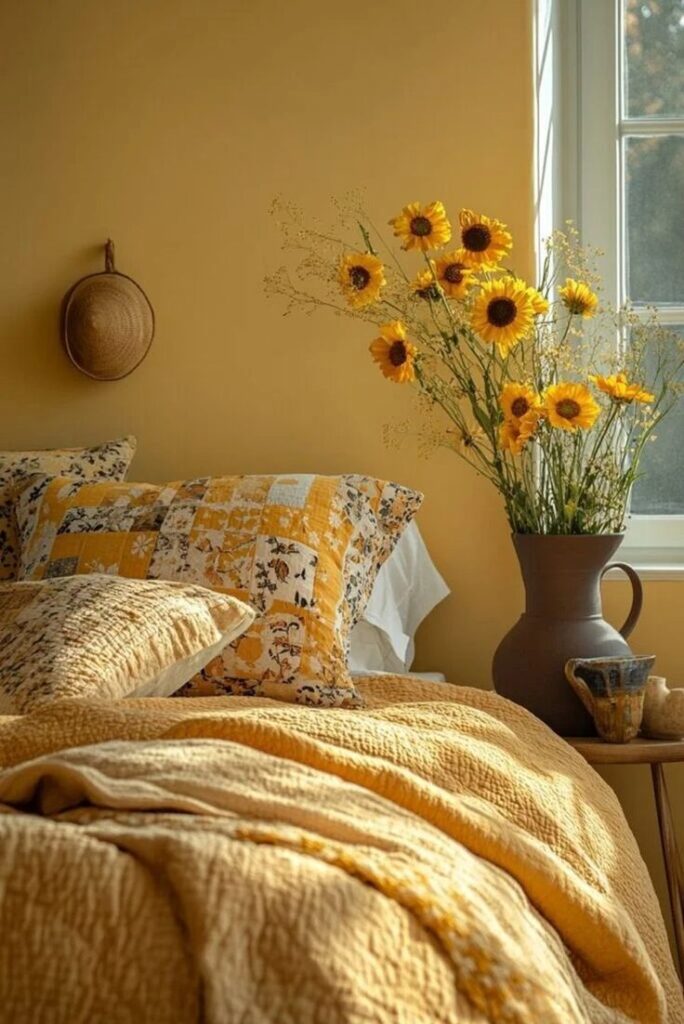
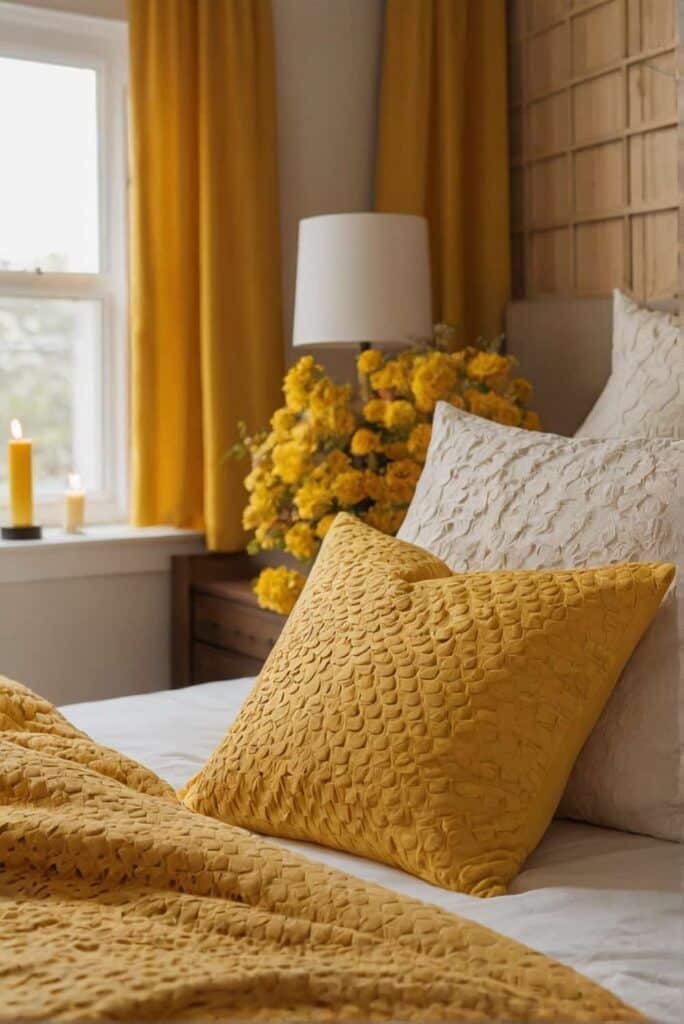
Yellow works well with different colors depending on the season. For spring and summer, combining yellow with fresh greens or light blues creates an airy feel.
In fall and winter, warmer tones like burnt orange, brown, or deep reds complement yellow and make spaces feel cozy. Adding soft blankets or curtains in these colors can update a room quickly.
Swapping out yellow accents—such as cushions or wall art—is an easy way to refresh the look without repainting or redecorating completely. This keeps the home feeling new throughout the year.
Latest Trends in Yellow Pantone Home Styling


Yellow Pantone shades are gaining attention in home design for their ability to brighten spaces without overwhelming them. Softer yellows like butter and pastel tones offer warmth and comfort. These hues work well in living rooms and bedrooms, creating a cheerful yet calm atmosphere.
Bold yellows are also popular, especially in kitchens and accent walls. They add energy and make spaces feel lively. Designers combine these yellows with neutral colors such as gray, white, or beige to balance the brightness.
Furniture and decor featuring yellow Pantone shades are trending too. Items like cushions, vases, and lamps in yellow add small pops of color without taking over a room.
Some homeowners use yellow in patterns. Geometric and floral designs mix yellows with other colors to create vibrant, playful looks.
| Trend | Description | Best Use |
|---|---|---|
| Soft Yellow | Light, soothing shades | Bedrooms, living rooms |
| Bold Yellow | Bright, energetic tones | Kitchens, accent walls |
| Yellow Accents | Small decor items with yellow highlights | Any room |
| Patterns | Mixing yellow with other colors in prints | Textiles, wallpapers |
Yellow Pantone styling remains versatile, fitting various tastes and spaces. It works comfortably in both modern and traditional homes.
- 74shares
- Facebook0
- Pinterest74
- Twitter0



